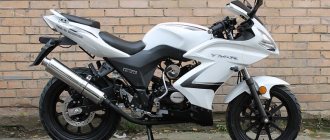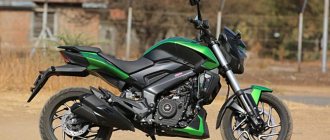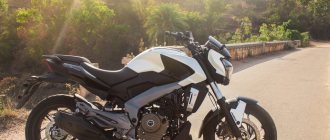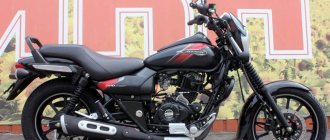An Indian with Austrian roots, produced under the name Bajaj Pulsar NS200, is a very interesting bike . This small-capacity bike is produced in India, at the same plant as the younger models of KTM, and it is distinguished from most other light motorcycles from Asia by its modernity and technology. It has a lot in common with the same KTM Duke 200 and 390 series, and this is one of the significant advantages of a native of India. At the same time, his price remained quite Indian, that is, affordable to a wide range of buyers.
Design
The Bajaj Pulsar 200 looks very good. Modern design without the cheap “frills” typical of Chinese motorcycles, an aggressively raised tail, a predatory silhouette... They did a great job on the appearance of the bike. “Pulsar” looks stylish , but at the same time laconic. A kind of urban naked in the best traditions of recent years, which does not try to be like famous models from other manufacturers.
Specifications of Bajaj Pulsar NS200
For such a baby, the specifications of the Bajaj Pulsar are truly outstanding. Modern technologies have been used in the motorcycle, which distinguishes it from the horde of Chinese small-capacity motorcycles, built according to the same patterns that were outdated a quarter of a century ago. Combined with an adequate price, the Pulsar generally looks like one of the best models in its class.
Engine
It has much in common with the power units installed on KTM motorcycles. 4 valves per cylinder, volume 199 cm3 , liquid cooling, three spark plugs - this is not just another Chinese engine copied from an ancient “Japanese” 30 years ago. The engine of the Bajaj Pulsar 200 produces a maximum power of 23.5 horsepower and a torque of 18.3 Nm , accelerating the bike to 135 km/h . The only thing that stands out from the overall picture is the carburetor. The Indians still saved money and decided not to install an injector, but even without it the Pulsar is very good. But the model was equipped with a normal oil filter instead of the Chinese “mesh”, and standard safety bars that protect the engine from damage in the event of a fall. from 0 to 100 km/h in less than 10 seconds .
Transmission
There are 6 gears in total , like in any other modern motorcycle. The gear ratios are short, so you will have to click the gearbox often, but this is the price to pay for decent acceleration dynamics. As practice shows, the Pulsar feels no less confident in city traffic than large bikes, and it gets through traffic jams even better than most of them.
Chassis and brakes
The diagonal steel frame has a high safety margin. There is a standard telescopic fork the front, and a Nitrox monoshock absorber with adjustable stiffness at the rear. Both wheels have petal brake discs (280mm front and 230mm rear) with Bybre . Considering the modest weight of the Pulsar motorcycle, its braking system is quite effective.
Electronics
It would be naive to expect any auxiliary electronic systems from a budget motorcycle. There are none here; all the electronics are familiar to any motorcyclist who has tinkered with the wires of his steel horse at least once. The only thing worthy of mention is the headlight - it produces quite good light. The directional light beam confidently dispels darkness and provides decent visibility on night roads.
Weight and dimensions
The dry weight of the Bajaj Pulsar 200NS reaches 145 kg . This figure can be called average by the standards of the class, but the powerful engine offsets the slightly excess weight. Subjectively, the motorcycle does not seem heavy, and while driving its weight is not felt at all. And it is distinguished by its modest dimensions - height, length and width are 198, 108 and 70 centimeters, respectively.
Controllability
Thanks to its carefully thought-out design and moderate weight and size characteristics, the Pulsar is incredibly easy to control. Many experienced bikers, accustomed to looking down on small-bore bikes, after riding it, admit that this Indian motorcycle has its own character, and excellent handling coupled with good dynamics is its main advantage.
Fuel consumption
It depends on driving conditions. In the city or on the highway, if you squeeze everything out of the bike that it is capable of, gasoline consumption can reach 4 liters per 100 km , but with a quiet ride it will not exceed 2.5-3 liters . Considering the gas tank volume is 12 liters , this is quite enough for a city motorcycle.
If Bajaj had been generous with an injector instead of a carburetor, the consumption could have been even less. The manufacturer recommends pouring AI-92 or AI-95.
Design
Having experience in assembling Dukes, no questions about material or geometry arose when starting production.
The Pulsar gets a steel space frame. On the one hand, this increased the weight, but on the other hand, the low center of gravity and close mutually beneficial cooperation with the Austrians had a positive effect on the handling and maneuverability of the motorcycle.
In an effort to simplify the design, they did not change the suspension much, making it according to the classical scheme . The front wheel is kept on the road by a standard telescopic fork (stay diameter 37 mm ), the rear wheel is supported by a mono-shock absorber based on a pendulum. The Austrians borrowed hydraulic support for both axles, and additional pneumatics for the rear. The air system gives the user a full range of settings
The highlights of the bike include a special gearbox setup, 3 spark plugs , a large selection of components (due to its similarity with KTM) and much more.
Exterior
If KTM focuses on off-road applications, then Bajaj, and especially the Pulsar series, are real street fighters.
Lightweight, maneuverable with a good frame that allows you to do wheelies or stops without much harm to the bike.
Front end
Thanks to its focus on sportiness, the motorcycle received a good, aerodynamic front fairing. Most of it is occupied by the irregularly shaped headlight. For optics, large ones use LEDs.
In the front appearance of the bike you can feel the hand of a professional designer, who did not just copy the design from the Japanese, but added several of his own modifications.
- High and low beam are collected under one glass . Below it, as separate elements, are a pair of DRL lights. The turn indicators are located outside the bike using candles. Mounted at the level of the bottom of the headlight, due to the usual white reflector for LEDs, they are visible from any position.
- No windshield .
The instrument panel at the front is covered with a small plastic shield.
Dashboard
The niche marked above protects the parallelogram of the instrument panel, into which the cup of the tachometer dial is inscribed, from incoming air. It is marked up to 12x1000 , red from 9.5x1000 , maximum power is provided only at 9x1000 .
Motorcycle price
A brand new Bajaj Pulsar will cost about 150 thousand rubles , depending on the interior. It’s worth this money because the only worthy alternative for this amount is the ancient 400 cc “Japanese”. Well, a used copy can be found for 80-100 thousand rubles .
Motorcycle Pulsar 220 DTS-Fi (2007): technical specifications, photos, videos
137 km/h / 85 mph
Adopting an aggressive stance in the crowded consumer motorcycle market, Bajaj introduced another surprise with the announcement of a brand new Pulsar model – the Pulsar 220F DTS-i. Billed as 'the Fastest Indian', it looks as though Bajaj are looking to capture drivers' imaginations with high-spec technology and blistering performance. Let's take a closer look at this exciting new offering from the tried-and-trusted manufacturer.
Design and Style
The Pulsar 220F aims to live up to its bold and aggressive stance in terms of design. The all-black theme dominates its body , including swing-arms, suspension, wheels and engine. The original Pulsar 220 was Bajaj's first bike to feature a front fairing and the bold styling of an athletic sports bike, and this new update maintains this edgy aesthetic. The brake calipers now feature a classy gold-plating finish. The Pulsar now features very stylish looking LED taillights. Its new split seat features a split grab rail for the pillion rider.
Instrument Console
In keeping with the other revamped models released in its new generation of bikes, Bajaj have upgraded the 220F's instrument console. Its all-digital panel features clear, bright digital displays for its speedometer, neutral blinker, trip meter, tachometer, low battery measure and fuel gauge. The enlarged tachometer is the dominant instrument, positioned in the middle of the console, with a fully digital display to the right and the LEDs on the left.
Engine and Gearbox
The Pulsar 220F is equipped with a meaty 220c, 4-stroke , air/oil-cooled DTSi engine. The engine offers a maximum power of 20.8 BHP at 8500 rpm , and a maximum torque of 19.12 NM at 7000 rpm . Its patented TRICS 3 technology and smart CDI system improve the bike's ignition timing and provide a smoother delivery of power, as well as temperature-based ignition mapping, using the largest venturi carburettor yet seen on a bike for the Indian market.
Acceleration and Top Speed
The bike's acceleration is generally very good, shooting from 0 to 60 kmmph in a blistering 4.1 seconds , and 0 to 100 in 9.5 seconds – these are great numbers. The bike is fitted with Bajaj's patented ExhausTEC (Torque Expansion Chamber) system, which gives the vehicle a higher rate of pickup at lower rpms, reducing the need to shift gears frequently to maintain acceleration. The smart tech also provides better engine torque at lower rpms, and the result is plenty of latent engine power, no matter what stage of riding you are at. The bike's pull is effortless, regardless of the load conditions heaped upon it. Built to be one of Bajaj's fastest bikes, it offers a top speed of 144 kmph.
Mileage
Bajaj Pulsar 200F boasts plenty of smart technology that, according to Bajaj, should guarantee improved fuel efficiency and reduced consumption. The bike delivers an average efficiency of 44 km/l , which is a respectable return for a bike in this class, although slightly lower than most budget buyers would like. The fuel tank has a capacity of 15 liters – 3.2 liters held in reserve, with 2.2 liters usable.
Comfort While Driving
Bajaj Pulsar 220F is a comfortable ride for drivers of all types. The bike's seat is surprisingly firm and well padded , making it more comfortable than its severe lines might first suggest. It features a largely upright seat that is suitable for city driving and a number of ergonomic features such as well-positioned footrests.
Repair and tuning
The small-capacity Bajaj breaks the stereotypes that budget Asian bikes fall apart as soon as they leave the dealership. For some reason, this inexpensive product from India stubbornly does not want to break down, and with timely maintenance, it will run smoothly year after year, racking up kilometers on its wheels. Some owners even invest in tuning, customizing the bike to suit themselves.
Repair
The Bajaj Pulsar motorcycle does not have any specific or common breakdowns. But thanks to its simple design, you can easily repair it yourself. You don’t need any special tools for this; any standard kit that you can buy at your nearest auto parts store will suffice.
Spare parts
They are inexpensive, and it is usually not difficult to find them in stock. Some parts of the engine and transmission are suitable from KTM bikes, but the price tag for Austrian parts is higher than for Indian ones.
Tuning
Most often, owners equip the Pulsar with a windshield, protective cages, sliders and other little things. Due to the budget nature of the bike, few people spend large sums on tuning, and besides, the Bajaj is already good, without any improvements.
Advantages and disadvantages
The Bajaj Pulsar 200 is a well-balanced bike . It belongs to the budget segment, but it has much more advantages than disadvantages, and for a reasonable price, buyers get a decent lightweight motorcycle.
Advantages
- Combination of price and quality. At a moderate cost, Bajaj is head and shoulders above the vast majority of Chinese competitors.
- Manufacturability . An engine similar to that of the KTM Duke 200, a 6-speed transmission, tenacious brakes and peppy dynamics allow the owner of the Bajaj to feel confident on the road.
- Reliability . The model is devoid of “childhood sores”, and, according to reviews, breakdowns are rare.
- Low cost of maintenance. Spare parts, tuning and consumables are inexpensive.
- High top speed. The Bajaj Pulsar is indeed capable of achieving the manufacturer's claimed top speed of 135 km/h.
Flaws
- Short passes . You will have to switch them frequently in city driving mode.
- Weak grip . It is very demanding on oil and tightening torques, which must always be remembered when servicing the bike.
- Switch problem . On early copies it sometimes failed, but this defect has long been eliminated.
Bajaj Pulsar 220 DTS-Fi
name = Pulsar 220 DTS-Fi aka = manufacturer = Bajaj class = engine = 220 cc single, 2 valve, 4 Stroke, EFI, air cooled with oil coolerBore x Stroke: 67 mm x 62.4 mmCompression ratio: 12.8:1 top_speed = auto km /h|135 (estimated) power = auto PS|20 torque = auto Nm|19.13 transmission = 5 speed manual sequential chassis = Double cradle twin suspension = Front: 37 mm telescopic hydraulic type auto mm|130 travel Rear: Elliptical section swingarm with twin hydraulic gas-charged shock absorbers; auto mm|101 travel brakes = Front: 260mm disc Rear: 230 mm disc tires = Front: 90/90-17 tubeless Rear: 120/80-17 tubeless rake_trail = wheelbase = length= convert|2035|mm|in width= convert |750|mm|in height= convert|1140|mm|in seat_height = dry_weight = Approx. convert|150|kg|lb wet_weight = fuel_capacity = related = Pulsar 200 DTS-i similar = The Bajaj Pulsar 220 DTS-Fi
is the latest addition to the Pulsar family of motorcycles from Bajaj Auto. Features differentiating this bike from other members of the DTS-i family include oil cooled, fuel injected engine, front and rear disc braking, tubeless tires, a digital speedometer console (recently introduced in all other Pulsar editions) and parabolic/ellipsoidal projector headlamps.
Bajaj displayed the 220 DTS-Fi at the Delhi Auto Expo 2006. The Indian national launch happened in July 2007.
Features and specifications
With this introduction, Bajaj Auto would achieve a close second in the race to offer a microprocessor-based fuel injected motorcycle to Indian customers, after Hero Honda's 125 cc Glamor FI motorcycle. cite news|url=https://www.thehindubusinessline.com/iw/2006/06/11/stories/2006061100891500.htm|title=Fuel-injected rivalry to spill on to the roads soon|publisher=Hindu Business Line] [ cite web url=https://www.moneycontrol.com/india/news/wheels/fuelinjectionfuel/ispulsardtsfiwo/market/stocks/article/233485 title=DTS-Fi accessdate=2007-04-10
] The new Pulsar has a longer wheelbase than its predecessor, factory-fitted front and rear disc brakes and detailed digital instrumentation. The Pulsar DTS-Fi generates a maximum power of 20 bhp and a maximum torque of auto Nm|19.12.
Engine technology
The acronym DTS-Fi stands for Digital Twin Spark Fuel Injection. Like DTS-i (which is the mother technology) the engine has two spark plugs, but, instead of conventionally positioned straight ports, the offset positioning of the ports generate high swirl and turbulence of the air fuel mixture in the combustion chamber. This results in highly efficient combustion that further results in exceptional mileage. Like the mother DTS-i technology, the DTS-Fi technology is a patented technology developed by Bajaj Auto R&D.
Owner reviews
I didn’t know about Bajaji at all, I was looking for a budget Chinese one, I looked towards used Japanese ones, but the budget was running out. As a result, I saw the Pulsar in the showroom by chance when I went to look at another motorcycle. I asked the managers, they told me that the bike with a KTM engine is assembled at the Kawasaki plant. Impressed. I sat and tried it on, returned the next day with the money and bought it. I skated for two full seasons, there were no breakdowns, I fell on my side once - the plastic held up. The motor is very reliable. Sergey, Moscow.
I live in India, and I can’t live here without my bike. I bought a new Pulsar last year, during which time I drove 20+ thousand km on the dead Indian roads, during this time I only changed the clutch, it constantly works in severe local traffic jams. The motor does not overheat even in the heat of +40. The speakers are impressive, the brakes are grippy. Anatoly, Delhi.
I bought a Pulsar NS 200 secondhand, with 12k mileage and a lot of tuning - the previous owner drove it twice to the Crimea. It pulls normally with a passenger and cargo, and holds the cruiser confidently at 110 mph. With a height of 182 cm, it is comfortable to sit, the passenger seat is cramped. There are no problems with consumption, nor with spare parts. I use 92nd gasoline, the consumption is higher than stated, but I have never increased more than 3.5 liters. Dmitry, Lobnya.
Interesting Facts
- Cooperation between manufacturers is mutually beneficial. Some of Bajaj's ideas found their way into KTM.
- An attempt was made to create Pulsar at the plant back in 2003 . But their own development was inferior to all competitors and they returned to it after the agreement with KTM.
- Edgar Heinrich worked on the design of the project . His past works include the legendary “goose”. BMW R 1200GS.
Conclusion
Bajaj Pulsar is one of the best motorcycles in its price range . It costs more than most “Chinese” ones, but is still much cheaper than “Japanese” and “European” ones, which are similar in characteristics. In addition, Bajaj is a well-known global brand, distributed on all continents and stably supporting all manufactured models with spare parts. This bike is definitely worth the money, don’t even doubt it.
Specifications
| Maximum engine power: | 23.52 l/s at 9500 rpm |
| Torque: | 18.3 N.m at 8000 rpm Nm |
| Working volume: | 199.5 cm3 |
| Motor type (cylinder arrangement, number of strokes): | 4-stroke. SOHC 4 valves liquid cooling 3 spark plugs per cylinder |
| Number of cylinders: | 1 |
| Number of valves: | |
| Intake type (Injector / Carburetor): | |
| Bore and stroke: | |
| Starting system (Electric starter, kick starter): | |
| Maximum speed in km/h: | 136 km/h |
| Cooling system: | Air |
| Transmission (gearbox): | Mechanical 6-speed |
| Clutch (Dry / Wet): | |
| Drive unit: | Chain |
| Frame: | Steel diagonal frame made of stamped elements |
| Chassis | |
| Suspension (front/rear travel): | |
| Brakes (Front/Rear): | |
| Wheels / Tires / Rubber: | |
| Dimensions and weight | |
| Dimensions (Length / Width): | |
| Seat height: | |
| Ground clearance: | |
| Curb weight: | |
| Wheelbase: | 1363 mm |
| Weight: | 152 kg |
| Fuel tank capacity: | 12 l. |
| Battery capacity: | |
| Year of release: | |
| Country of Origin: |
and dignity
The motorcycle, in principle, has a holistic character, unlike many Chinese models, which have become famous for their obvious “defects.”
The advantages include:
- no vibrations despite 1 cylinder;
- the price is Chinese, and the quality is Austrian;
- low center of gravity;
- maneuverability.









